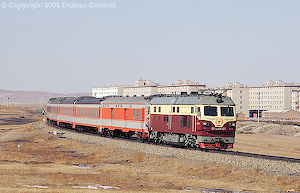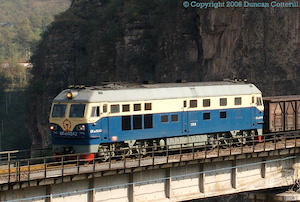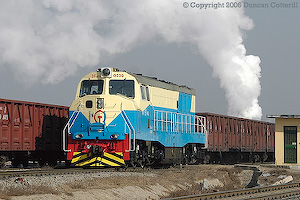DF4D Class Co'-Co' Diesel-Electrics
The DF4D marked the most significant development of the DF4 design since the introduction of the DF4B in the mid 1980s. As well as passenger and freight versions, several other sub classes have been introduced over the years.
DF4D 3303 is a DF4DK, geared for 170 km/h operation. The loco is seen working east on the Harbin - Mudanjiang main line in an area where DF4DK handle most fast passengers. The livery is the easiest way to differentiate between the standard passenger DF4D and the DF4DK.
The first locos were built by Dalian for passenger work in 1996. They had a 16V240ZJD engine with a rated power output of 2940 kW / 4000 HP and a maximum speed of 145 km/h. Unlike earlier DF4 variants, the "D" was included in the numbers carried on the locos. Numbers started at DF4D 0001.
The first 150 or so were built with the same bodyshell as the DF4C but later locos have a less angular cab roof and additional handrails below the cab windows. The earlier locos now appear to have been retrofitted with these features (see picture of DF4D 0105). The standard DF4D passenger locos carry an attractive maroon/cream livery reminiscent of the original DB intercity livery.
A DF4DF with electric train heating generator was introduced in 1999 but only a small number appear to have been built. They may have been superseded by the DF4DK (K for kuai = fast) with a maximum speed of 170 km/h. This subclass was introduced in 2000 and built in significant numbers. They are numbered in the DF4D 3xxx series and carry a snazzier red and cream livery.
The main line freight version of the design was introduced in 1998 with a maximum speed of 100 km/h. These locos are simply known as DF4D (like the original passenger design) and carry a very similar blue and cream livery to the 5xxx series DF4C. Most are numbered in the DF4D 4xxx series but there are some DF4D 0xxx examples as well. A few have been noted with rogue numbers without the "D" suffix. It's easy to confuse the freight DF4D with the earlier DF4C design as the body design is similar and the livery almost identical. The DF4C profile includes information on how to tell the difference.
DF4C or DF4D?
Locos of classes DF4C and DF4D look very similar at first glance but it's relatively easy to tell the difference between the two by looking at the cab roof. The DF4C has a more angular roof profile with a steeper slope to the front part of the roof and a rectangular headlight housing. The DF4D cab roof has a much gentler slope at the front and the headlight has a round housing. The pictures above show a DF4C (top) and a DF4D below allowing a comparison of the two designs.
There is also a DF4DD, a road-switcher version of the design introduced in 1999. These locos are hood units with a single cab and a wide nose that has obviously been influenced by recent EMD designs. They don't appear to have been built in quantity but can be seen on several mining systems where long hauls and heavy loads require something bigger than the usual industrial diesels.
Other versions of the DF4D that currently only exist in very small numbers include the DF4DJ with AC drive. The NYJ2 power cars used on high speed unit trains on routes such as Beijing to Tianjin may well be DF4Ds under the streamlining.



